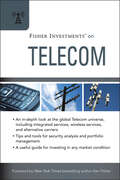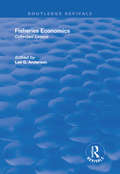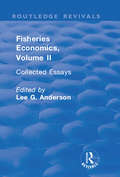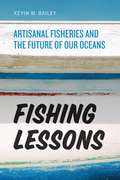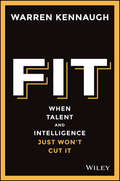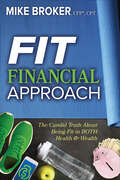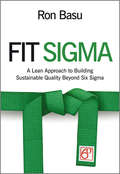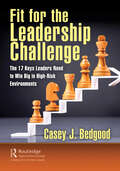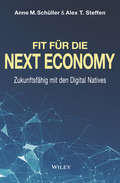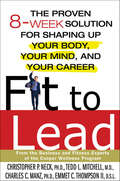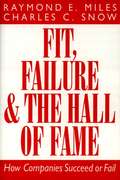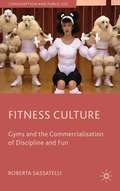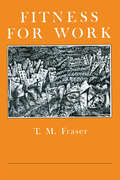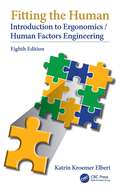- Table View
- List View
Fisher Investments on Telecom
by Fisher InvestmentsThe Fisher Investments On series is designed to provide individual investors, students, and aspiring investment professionals the tools necessary to understand and analyze investment opportunities--primarily for investing in global stocks.Each guide is an easily accessible primer to economic sectors, regions, or other components of the global stock market. While this guide is specifically on Telecom, the basic investment methodology is applicable for analyzing any global sector, regardless of the current macroeconomic environment.Following a top-down approach to investing, Fisher Investments on Telecom can help you make more informed decisions within the Telecom sector. It skillfully addresses how to determine optimal times to invest in Telecom stocks and which Telecom industries have the potential to perform well in various environments.Divided into three comprehensive parts--Getting Started, Telecom Details, and Thinking Like a Portfolio Manager--Fisher Investments on Telecom:Explains some of the sector's key macro drivers--like interest rates, regulation, and risk aversionShows how to capitalize on a wide array of macro conditions and industry-specific features to help you form an opinion on each of the industries within the sectorTakes you through the major components of the industries within the global Telecom sector and reveals how they operateOffers investment strategies to help you determine when and how to overweight specific industries within the sectorOutlines a five-step process to help differentiate firms in this field--designed to help you identify ones with the greatest probability of outperformingFilled with in-depth insights, Fisher Investments on Telecom provides a framework for understanding this sector and its industries to help you make better investment decisions--now and in the future. With this book as your guide, you can gain a global perspective of the Telecom sector and discover strategies to help achieve your investing goals.
Fisher Investments on Utilities (Fisher Investments Press #28)
by Andrew S. Teufel Fisher Investments Theodore GillilandThe Fisher Investments On series is designed to provide individual investors, students, and aspiring investment professionals the tools necessary to understand and analyze investment opportunities—primarily for investing in global stocks. Each guide is an easily accessible primer to economic sectors, regions, or other components of the global stock market. While this guide is specifically on Utilities, the basic investment methodology is applicable for analyzing any global sector, regardless of the current macroeconomic environment. Following a top-down approach to investing, Fisher Investments on Utilities can help you make more informed decisions within the Utilities sector. It skillfully addresses how to determine optimal times to invest in Utilities stocks and which Utilities industries have the potential to perform well in various environments. Divided into three comprehensive parts—Getting Started, Utilities Details, and Thinking Like a Portfolio Manager—Fisher Investments on Utilities: Explains some of the sector’s key macro drivers—like regulation, economic cycles, and investor sentiment Shows how to capitalize on a wide array of macro conditions and industry-specific features to help you form an opinion on each of the industries within the sector Takes you through the major components of the industries within the global Utilities sector and reveals how they operate Offers investment strategies to help you determine when and how to overweight specific industries within the sector Outlines a five-step process to help differentiate firms in this field—designed to help you identify ones with the greatest probability of outperforming Filled with in-depth insights, Fisher Investments on Utilities provides a framework for understanding this sector and its industries to help you make better investment decisions—now and in the future. With this book as your guide, you can gain a global perspective of the Utilities sector and discover strategies to help achieve your investing goals.
Fisher-Price Toys, Inc.
by Scott Ward Steven L. DiamondReviews new product introduction and pricing decisions for a riding toy designed for preschool children. Designed to provide background in buyer behavior, market analysis, and corporate strategy.
Fisheries Economics, Volume I: Collected Essays (Routledge Revivals)
by Lee G. AndersonThis title was first published in 2002: This important collection of international research on fisheries economics offers a comprehensive source of contemporary research on key topics in the field, as well as presenting the history of how the economic theory of fisheries exploitation has developed. Bringing into focus a wide range of inquiry, this volume concentrates most particularly on the traditional economic problem of optimal resource allocation. Individual papers examine fundamental issues including, the lack of efficiency of open access and the specification of exactly what dynamic efficiency entails. Fisheries Economics is an invaluable research reference collection for the libraries of academic and other professional economists, as well as an indispensable resource for those studying across the fields of natural resources, fisheries economics and particularly fisheries management.
Fisheries Economics, Volume II: Collected Essays (Routledge Revivals)
by Lee G. AndersonThis title was first published in 2002: This important collection of international research on fisheries economics offers a comprehensive source of contemporary research on key topics in the field, as well as presenting the history of how the economic theory of fisheries exploitation has developed. Bringing into focus a wide range of inquiry, this second volume concentrates on extensions, analysis of management agencies and applications. Individual papers examine fundamental issues including, multispecies models, international utilization and recreational fisheries. Fisheries Economics is an invaluable research reference collection for the libraries of academic and other professional economists, as well as an indispensable resource for those studying across the fields of natural resources, fisheries economics and particularly fisheries management.
Fisheries and the Law in Europe: Regulation After Brexit (Legal Perspectives on Brexit)
by Jonatan Echebarria FernándezExamining fisheries, Brexit, the Trade and Cooperation Agreement (TCA) and its consequences for the Fishing Industry in the UK and the EU, this book explores key issues within the complex topic of fisheries after Brexit. Assessing the new fishing relationship between the UK and the EU, which will continue to develop over the next decade, it provides an important study of the state of fisheries post-Brexit. Taking a cross-cutting economic, legal and policy approach, the book outlines the social and economic impacts of Brexit on the UK and EU fishing industries. It critically analyses the provisions relevant to fisheries in the TCA, reflects on the bilateral fishing negotiations between the EU, UK and Norway, providing inferences as to what the "new and special relationship" might be in fisheries. It then focuses on the 2020 Fisheries Act and explores internal divergences in the nations of the UK because of devolution. Taking an international approach, the work offers an exploration of cooperation in fisheries enforcement, international and regional obligations in marine conservation, and the new horizons for the UK in international fisheries organizations and arrangements now it is no longer a member of the EU. It offers an overview of expert opinion on fisheries post-Brexit, highlighting lessons learned and future developments for fisheries in a post-Brexit world. Having finally signed the Trade and Cooperation Agreement on 31 December 2020 after tense negotiations, the United Kingdom and European Union have found themselves in a new fisheries relationship. This book maps the complex social, economic, legal and policy issues of fisheries in a post-Brexit world and will be of interest to stakeholders and scholars.
Fishing Lessons: Artisanal Fisheries and the Future of Our Oceans
by Kevin M. BaileyFish bones in the caves of East Timor reveal that humans have systematically fished the seas for at least 42,000 years. But in recent centuries, our ancient, vital relationship with the oceans has changed faster than the tides. As boats and fishing technology have evolved, traditional fishermen have been challenged both at sea and in the marketplace by large-scale fishing companies whose lower overhead and greater efficiency guarantee lower prices. In Fishing Lessons, Kevin M. Bailey captains a voyage through the deep history and present course of this sea change—a change that has seen species depleted, ecosystems devastated, and artisanal fisheries transformed into a global industry afloat with hundreds of billions of dollars per year. Bailey knows these waters, the artisanal fisheries, and their relationship with larger ocean ecology intimately. In a series of place-based portraits, he shares stories of decline and success as told by those at the ends of the long lines and hand lines, channeling us through the changing dynamics of small-scale fisheries and the sustainability issues they face—both fiscal and ecological. We encounter Paolo Vespoli and his tiny boat, the Giovanni Padre,in the Gulf of Naples; Wenche, a sea Sámi, one of the indigenous fisherwomen of Norway; and many more. From salmon to abalone, the Bay of Fundy to Monterey and the Amazon, Bailey’s catch is no fish tale. It is a global story, casting a net across waters as vast and distinct as Puget Sound and the Chilean coast. Sailing across the world, Bailey explores the fast-shifting current of how we gather food from the sea, what we gain and what we lose with these shifts, and potential solutions for the murky passage ahead.
Fishing, Foraging and Farming in the Bolivian Amazon
by Lisa RinghoferEmpirical in character, this book analyses the society-nature interaction of the Tsimane', a rural indigenous community in the Bolivian Amazon. Following a common methodological framework, the material and energy flow (MEFA) approach, it gives a detailed account of the biophysical exchange relations the community entertains with its natural environment: the socio-economic use of energy, materials, land and time. Equally so, the book provides a deeper insight into the local base of sociometabolic transition processes and their inherent dynamics of change. The local community described in this publication stands for the many thousands of rural systems in developing countries that, in light of an ever more globalising world, are currently steering a similar - but maybe differently-paced - development course. This book presents insightful methodological and conceptual advances in the field of sustainability science and provides a vital reader for students and researchers of human ecology, ecological anthropology, and environmental sociology. It equally contributes to improving professional development work methods.
Fit
by Warren KennaughUnderstand where you fit to understand where you'll excel Fit: When Talent and Intelligence Just Won't Cut It answers the fundamental performance questions that people have asked for generations. Why is that some individuals are consistently high performers, how do they keep performing in varying situations, organisations and contexts, why can some people just not seem to be able to crack that code, and why do some individuals perform exceptionally well in certain organisations but not in others? This fresh new book challenges current thinking about the war for talent and the role intelligence plays in high performance sport and business. Over 3,000 profiles of elite corporate managers and professional elites have been studied to find the answers as to why certain individuals consistently get exceptional results and why great talent doesn't transfer across teams and businesses. Fit considers real live cases and well-known examples of spectacular successes and failures through the lens of the Hogan Personality Tools. This shows how elite performance is dependent on three things; understanding what role your behaviours are best suited to, what culture you perform your best in and how you're likely to derail your career. Armed with this knowledge, this innovative text allows you to connect the dots on your past performances and prepares you to find roles, organisations and teams which best fit you -opening the door for elite performance. Instead of talent management and changing behaviour, look to Fit as a key to your performance improvement. You'll find that performance does not have a one-size-fits-all formula-it is bespoke, personal and different for each individual. Understand how you can align your natural style with the right roles to achieve elite performance in your professional and personal lives Appreciate your unique behavioural patterns that impact personal and team success Discover that true success is not totally dependent on talent and intelligence, but on discovering what you're good at and where you fit. Fit: When Talent and Intelligence Just Won't Cut It unearths the hidden traits of elite performance and enables you to find your fit to further enhance your engagement and success.
Fit Financial Approach: The Candid Truth About Being Fit in BOTH Health & Wealth
by Mike BrokerA no BS, real world approach to gaining the empowerment, knowledge, and direction needed to improve one’s life.
Fit Sigma: A Lean Approach to Building Sustainable Quality Beyond Six Sigma
by Ron BasuTo some, the near perfection of the Six Sigma management system appears to be an impossible ideal, especially for small and medium enterprises. FIT SIGMATM, a flexible and more sustainable approach, was developed through the integration of the ‘hard' Six Sigma approach with Lean Enterprise philosophy. It consists of three elements; fitness for purpose, fitness for improvement and integration, and fitness for sustainability. FIT SIGMA: A Lean Approach to Building Sustainable Quality Beyond Six Sigma shows how this tripartite approach can be used to add value to both large and small organisations through improved use of resources, and through the provision of improved customer satisfaction. It shows that a holistic approach to operational excellence underpinned by a data driven methodology can be applied equally to the manufacturing, service or public sectors. As the Six Sigma philosophy has evolved in recent years to take into account new challenges faced by companies, including climate change, green supply chain, emerging markets and a growing service sector, so FIT SIGMATM has also adapted itself to these new demands. FIT SIGMA: A Lean Approach to Building Sustainable Quality Beyond Six Sigma covers key developing areas including: Sustainability and Environment Non-profit organizations Service Operations Supply Chain Management Project Management Emerging Markets Small and Medium Enterprises Green Thinking Each chapter contains practical implementation guide, illustrative examples and case studies, and concludes with a summary of key elements for ease of reference and revision. In addition the book includes a comprehensive glossary of common terms and phrases used in managing quality, along with an appendix which illustrates the applications of basic statistics in Six Sigma and Fit Sigma.
Fit for Growth: A Guide to Strategic Cost Cutting, Restructuring, and Renewal
by Vinay Couto John Plansky Deniz CaglarA practical approach to business transformation Fit for Growth* is a unique approach to business transformation that explicitly connects growth strategy with cost management and organization restructuring. Drawing on 70-plus years of strategy consulting experience and in-depth research, the experts at PwC’s Strategy& lay out a winning framework that helps CEOs and senior executives transform their organizations for sustainable, profitable growth. This approach gives structure to strategy while promoting lasting change. Examples from Strategy&’s hundreds of clients illustrate successful transformation on the ground, and illuminate how senior and middle managers are able to take ownership and even thrive during difficult periods of transition. Throughout the Fit for Growth process, the focus is on maintaining consistent high-value performance while enabling fundamental change. Strategy& has helped major clients around the globe achieve significant and sustained results with its research-backed approach to restructuring and cost reduction. This book provides practical guidance for leveraging that expertise to make the choices that allow companies to: Achieve growth while reducing costs Manage transformation and transition productively Create lasting competitive advantage Deliver reliable, high-value performance Sustainable success is founded on efficiency and high performance. Companies are always looking to do more with less, but their efforts often work against them in the long run. Total business transformation requires total buy-in, and it entails a series of decisions that must not be made lightly. The Fit for Growth approach provides a clear strategy and practical framework for growth-oriented change, with expert guidance on getting it right. *Fit for Growth is a registered service mark of PwC Strategy& Inc. in the United States
Fit for the Leadership Challenge: The 17 Keys Leaders Need to Win Big in High-Risk Environments
by Casey J. BedgoodThe key to effective leadership is being fit for the challenge. Leadership is a perpetual boxing match in many respects in which preparation, stamina and skill are required. Only the strongest survive. Every decision and tollgate along the career journey is laden with risk. Those leaders who harness risk to their advantage will land the knockout punch in every fight. The only question is how many leaders will be fit enough for the challenge? The purpose of this book is to provide insight as to how risk impacts every aspect of leadership, including the mundane, routine and nonglamorous aspects of leadership. This is important because often the small things can easily turn into big disruptors. Moreover, the end goal is to equip leaders with a journey map and quick guide to win in high-risk environments. Change is the new normal and only constant in today’s world. As change increases, so will risk and its subsequent impacts on humanity. This includes leaders, organizations and customers. No one is exempt. In this book, readers learn how to: Determine which career battles to fight and which ones to avoid Prepare to fight the unavoidable challenges along the career journey Leverage risk to choose the right leaders for the team Leverage risk to invest time wisely and avoid wasting it Leverage risk to predict, identify and resolve leadership burnout Risk assess leadership credentials so only those that produce a return are added to the portfolio Risk assess performance outcomes so the path ahead is smooth sailing instead of a rough ride Leverage risk so high performance is a reality instead of a pipe dream Leverage risk to find the right leadership sponsor
Fit für die Next Economy: Zukunftsfähig mit den Digital Natives
by Anne M. Schüller Alex T. SteffenMit hohem Tempo, digitaler Kernkompetenz und einem Riecher für Innovationen treibt die Generation der Jungunternehmer neue Geschäfts-, Arbeits-, Finanzierungs-, Kommunikations-, Kauf- und Lebensmodelle voran. Diese sind von tradierten Modellen völlig entkoppelt. Für immer mehr etablierte Unternehmen stellt sich hingegen die Anschluss- und Überlebensfrage. Und sie wird von medialen Poltergeistern kräftig befeuert. Doch das bringt am Ende niemanden weiter. Die digitale Transformation lebt vom raschen Handeln. Hier tritt die Millennial-Generation auf den Plan. Sie ist die bestausgebildete und zugleich kreativste Generation, die wir je hatten. Sie will nicht herrschen, sondern gestalten. Der Wandel, den sie technologisch und kulturell in Gang gebracht hat, wird der größte aller Zeiten sein. Genau diese Generation kann der Old Economy helfen, sich auf das Neuland der Zukunft mit seinen immer schnelleren Zyklen vorzubereiten, also: digitaler zu denken, kollaborativer zu handeln, agiler zu werden und Disruptives zu wagen. Nur so können am Ende auch Existenzen gesichert werden. Den etablierten Unternehmen kann der Wandel hin zur Next Economy nur gelingen, wenn die "Jungen" zu Mentoren der "Alten" werden. Bis jetzt war das stets genau umgekehrt. Veränderungsbereitschaft und der Wille, die Zeichen der Zeit zu verstehen, sind hierfür ein Muss. Doch was, wenn es mit der Verständigung mal nicht so klappt? Dann werden Brückenbauer und Trittsteinleger gebraucht, um die wachsende Kluft zwischen "Alt" und "Neu" zu überwinden und zu gemeinsamem Handeln zu kommen. Alex T. Steffen (Jahrgang 1990) ist Vertreter der Next Economy. Selbstbewusst und kompromisslos erläutert er, wie das Business der Zukunft funktioniert, und warum die "Alten" die "Jungen" so dringend brauchen. In der digitalen Welt kommt nämlich ein entscheidender Faktor hinzu: die Bereitschaft und auch die Fähigkeit, mit ständiger Veränderung umzugehen. Jüngere Generationen sind seit je her in dieser Disziplin besser. Neu ist der radikale Wandel der Geschäftsmodelle. Die "jungen Wilden" verstehen es quasi intuitiv, die digitale Transformation dafür zu nutzen. Rasche Anpassungsfähigkeit ist hierbei ein Muss - und das schaffen die Millennials unglaublich gut. Als digital fitte und global geprägte Generation erkennen sie Potenziale blitzschnell, können Marktdifferenzen identifizieren und Lösungen ganz neu kombinieren. Anne M. Schüller steht stellvertretend für die Old Economy. Sie erläutert, wie traditionelle Unternehmen die Herausforderungen annehmen und in Chancen umwandeln können. Gemeinsam mit Alex T. Steffen zeigt sie Mittel, Wege und Maßnahmen, mit denen klassische Organisationen ihre internen Strukturen und Prozesse auf Zukunftsfähigkeit trimmen können. Sie empfehlen eine ganze Reihe von Vorgehensweisen, mit denen das Arbeitsumfeld millennialtauglicher und Geschäftsmodelle kundenfreundlicher gestaltet werden können. Dabei unterscheiden sie zwischen "Quick wins", die rasche Erfolge möglich machen, und "Big wins", die auf die Schnellstraße zur Next Economy führen.
Fit für die digitale Arbeitswelt: Erfolgreich in die berufliche Zukunft mit dem Kompetenz-MUSKEL-Modell
by Martin-Niels DäflerSpätestens seit Corona definieren wir „arbeiten“ anders als früher: Homeoffice statt Einzelbüro. Zoom-Meeting statt. Teambesprechung in der Firma. Ständig neue Projekte statt 08/15-Jobs. Sich selbstständig seine Aufgaben suchen, statt unmissverständliche Order vom Chef/von der Chefin erhalten. Vormittags sich mit der besten Freundin zum Frühstück treffen, dafür bis spät abends am Laptop sitzen. Willkommen in der neuen Arbeitswelt!Das Virus hat die Veränderung von Gesellschaft und Wirtschaft zwar beschleunigt. Doch schon längst davor haben. Digitalisierung und Globalisierung dafür gesorgt, dass die Art und Weise, wie wir zusammenarbeiten und -leben anderen Regeln gehorcht als vor zehn oder gar 20 Jahren. Und: Diese Entwicklung wird sich weiter fortsetzen, gar beschleunigen.Algorithmen und Roboter sind uns schon längst bei jedweden Routinetätigen überlegen und werden ihren Abstand noch vergrößern. So bleiben uns Menschen auf Sicht gesehen folglich jene Tätigkeiten, bei denen Kompetenzen gefragt sind, die uns Computer und Maschinen auf absehbare Zeit nicht streitig machen werden: Kreativität, Empathie und intuitiv-analytisches Denken. Dabei ist auch klar – nicht als Einzelkämpfer werden wir diese Kompetenzen benötigen, sondern als Teil von (agilen) Teams, die sich immer wieder neu zusammensetzen. So erlangen Kommunikations- und Konfliktlösungsfähigkeiten eine noch höhere Bedeutung, als sie sie ohnedies schon besitzen.Dieser Ratgeber verrät Ihnen, welche Eigenschaften und Fertigkeiten in der Arbeitswelt 4.0 gefragt sind und wie man die erforderlichen Kompetenzen im Berufsalltag erlangen kann. Praxistaugliche, direktanwendbare Methoden, Werkzeuge und Tipps zeigen Ihnen den erfolgreichen Weg in die neue Arbeitswelt.
Fit für die digitale Zukunft: Trends der digitalen Revolution und welche Kompetenzen Sie dafür brauchen (Fit for Future)
by Carsten LexaDie Digitalisierung verändert die Gesellschaft, sie stellt neue Anforderungen an die Menschen und führt zu neuen Herausforderungen. Das ist inzwischen hinreichend bekannt. Was aber werden konkret die Herausforderungen sein, denen sich die Menschen stellen müssen, welche Fähigkeiten müssen sie sich aneignen und wie können sie sich optimal auf die kommenden Veränderungen vorbereiten? In dem Buch geht es nicht um einen theoretischen Blick in die Kristallkugel, sondern der Autor greift die schon erkennbaren Veränderungen auf und entwickelt daraus Handlungsempfehlungen, um eine Vorbereitung auf die Veränderungen zu ermöglichen. Dabei geht es um einen zusammenhängenden Blick auf die Fragen, die in absehbarer Zukunft relevant werden, wie z.B. Veränderungen in der Art des Zusammenlebens, dem Verhältnis von Staat und Bürger oder der Vermittlung von Fähigkeiten und Wissen. Ziel des Buches ist es, dem Leser nicht einen abstrakten Zugang zu wesentlichen Bereichen der Digitalisierung zu ermöglichen, sondern konkrete Themen, die für den Leser schon sichtbar sind, zu analysieren, die Hintergründe aufzuzeigen und ihm die Angst vor den kommenden Veränderungen zu nehmen.
Fit to Lead: The Proven 8-Week Solution for Shaping Up Your Body, Your Mind, and Your Career
by Charles C. Manz Christopher P. Neck Tedd L. Mitchell Emmet C. Thompson IIA proven program to help busy executives get Fit to Lead.Are you a leader at work, at the expense of your health? Did you give up exercise after college, and stop watching your diet when you made it to senior partner? Are too little sleep, fast food, and a hectic, catch-up lifestyle all you allow yourself?This proven, simple program is based on the sound principles that have helped thousands of top executives, including President George W. Bush, get - and stay - in shape. The results are not just looking and feeling better, but performing better on the job, becoming a more effective leader, and inspiring others to follow your lead.
Fit, Failure & the Hall of Fame
by Raymond E. Miles Charles C. SnowIn this incisive analysis of corporate success and failure, the authors maintain that success is derived from a mix of ingredients--a company's strategy, its structure, and its processes working in concert. This book will supply managers with the fundamentals of achieving lasting success.
Fit, Failure and the Hall of Fame
by Raymond E. Miles Charles C. SnowManagers often become frustrated when, after making Herculean efforts to launch a better product, create a superior structure, or improve processes, success remains a distant and elusive goal. But genuine success does not come from any single action-or any random group of actions-caution Raymond Miles and Charles Snow in this incisive analysis of success and failure. Instead, they argue, success is achieved when the strategy, structure, and processes of a company "fit" together: operations then run smoothly inside and out, more is done with less, and customers are satisfied. Companies that go a step further to create exceptionally innovative strategy-structure-process packages-for example, Carnegie Steel was the first to create a vertically integrated, centralized management structure within the steel industry-often develop a record of accomplishments and reputation considerable enough to propel them into a mythical corporate Hall of Fame. Based on studies of dozens of companies to which they have applied this concept of "fit," the authors explain how success and failure can be predicted. Examining the causes of success and failure historically, they describe how such companies as General Motors and Sears, Roebuck-both Hall of Fame candidates-earned their legendary status by pioneering new forms of organization to fit the strategy-structure-process combination demanded by the marketplace at the time. Miles and Snow relate historic successes to current successes, explaining how even the most thriving companies of today-including Wal-Mart, Rubbermaid, and General Electric-could lose their way and become "misfit" companies. They describe in detail the path to misfit and what pitfalls to avoid to stay on the right track. Looking to the future, the authors examine new shapes organizations will take, including various types of "networks" and a promising new form that they call the "spherical" organization. Finally, Miles and Snow detail the key to long-term corporate health: dynamic fit. Dynamic fit allows managers to ensure flexibility and ongoing adaptation to the marketplace. Without it, the authors warn, success is fragile. With it, companies can develop their own recipe for success that works consistently no matter what corporate climate the future holds.
Fitbit
by Regina E. Herzlinger Christine Snively Sarah MehtaIn 2016, Fitbit remained the world's leading producer of activity trackers-an increasingly crowded space-with over 21 million units sold that year. Fitbit's suite of products allowed users to track the number of steps taken, calories burned, and heart rate activity. Fitbit devices were marketed to individual consumers as well as corporate wellness programs and employers. Though Fitbit was primarily focused on wellness, should management consider evolving into a chronic disease management company?
Fitness Culture
by Roberta SassatelliThis book provides a sociological perspective on fitness culture as developed in commercial gyms, investigating the cultural relevance of gyms in terms of the history of the commercialization of body discipline, the negotiation of gender identities and distinction dynamics within contemporary cultures of consumption.
Fitness For Work: The Role Of Physical Demands Analysis And Physical Capacity Assessment
by T. M. FraserOffers an occupational ergonomic analysis of medical selection procedures for disabled and able-bodied labour-market entrants. The book re-examines the concept of fitness for work and emphasizes humanitarian and legislative factors.
Fitter, faster, stronger, smarter
by Miranda BanksThrough her work as a performance psychologist with elite professional sportspeople, Miranda Banks knows the challenges faced by those striving to achieve. Enriched by real-life stories from high-performing people in sport and business, Fitter, Faster, Stronger, Smarter provides you with a cohesive and practical framework for reaching your full potential. Using a unique combination of performance psychology, mental-skills training and behavioural modification, Miranda will inspire you to bring out your best performances. Whether you want to climb the corporate ladder, play a better game of tennis or feel fulfilled and happy, FFSS provides you with strategies and a pathway for reaching your goals.
Fitting the Human: Introduction to Ergonomics/Human Factors Engineering, Eighth Edition
by Katrin Kroemer ElbertThe aim of this book is to provide “human engineering” for workplaces, tools, machinery, computers, shift work, lighting, sound, climate, work demands, offices, vehicles, healthcare, and the home – and everything else that we can produce – to suit the human body and mind. Now being published in its eighth edition, Fitting the Human focuses on the primary ergonomic task of accommodating the human with the appropriate selection of equipment and tools, work requirements and procedures, physical and social conditions at work, and working hours and shift arrangements.This book provides the ergonomic information needed for the user-friendly design of tasks, equipment, and workplaces. It follows the successful format of previous editions, with updated information and practical guidelines that augment the previous information. It offers refreshed information on ergonomic design for the home and workplace, contemporary ways of working, healthcare and medicine, and artificial intelligence and autonomy. This text also recognizes that cultural differences in living and working vary around the world, so additional insights are offered into ergonomics in global cultures and regions. This title will help the reader understand how to plan and design an overall system and its details to fit the human.Published under the mantra of “solid information, easy to read, easy to understand, easy to apply,” Fitting the Human is written for students and professionals in ergonomics, human factors, product and work design, safety, architecture, management, and all fields of engineering.
Five Basic Institution Structures and Institutional Economics
by Shaorong SunThis book discusses a development in institutional economics and management science, which provides engineering methods for institution design. Based on the "Sun Diagram" created by the author, it uses graphics and calculations to explain that there are only five fundamental management institution structures, each of which has a particular management effect. It also demonstrates that production activities should be managed with different institutions according to the differences in externalities. This significant book suggests ways of using institution design to tackle the key challenges faced by societies today, such as environmental pollution, over-consumption of natural resources, carbon emissions, world peace issues and stagnating productivity levels.
